One of my most viewed videos is an animation I made in 2011, showing that a common Dutch type of junction design with protected cycle tracks would in principle fit in American streets. To deal with many questions I showed real examples of that particular junction design in a second video. But there were still some unanswered questions that kept coming back and I had therefore planned to make a new follow-up to better explain this type of design. Then Dick van Veen, a Dutch senior city planner and traffic engineer at Mobycon asked me if he could use parts of both my videos for a project earlier this month in Canada. So I decided that the new video had to be made right now. My own ideas coupled with Dick’s professional expertise led to a new video which he has indeed used in a presentation. I heard it was very well received. I planned to publish a post with this new video on a later date.

By sheer coincidence my initial video got a lot of renewed attention when Nick Falbo published his interpretation of the design and the way it could be implemented in the US. After his publication a lot was written all over the internet in comments, tweets and forum discussions. Prof. Peter Furth from Boston’s Northeastern University showed me some of the questions he had received directly, with his answers that I fully agreed with. With such a commotion it is high time I publish my own follow-up video with an explaining post. So here we go!
Common Dutch Road Design
There are many questions about the status of this design. How common or standard is it? Some people argue it is not the only solution and it is in fact not the most used solution in the area where they live. I agree with the response of Prof. Peter Furth to this: “That’s true in smaller cities, which have few major traffic roads and where signalized intersections have been replaced with roundabouts in great numbers. But in larger cities, cycle tracks along the main arteries are routine, as are signalized intersections where such arteries meet. And wherever traffic arteries with cycle tracks meet at a signalized intersection, this is the routine, standard design. You can see scores of them in the Hague, Rotterdam, and Amsterdam.”
It is a fact that in the Dutch situation protected cycle tracks alongside main streets do not stop at junctions, but continue in one form or another on the junction itself, so that such a junction can be traversed by people of all ages and abilities (cycling or walking) in a safe and convenient way.
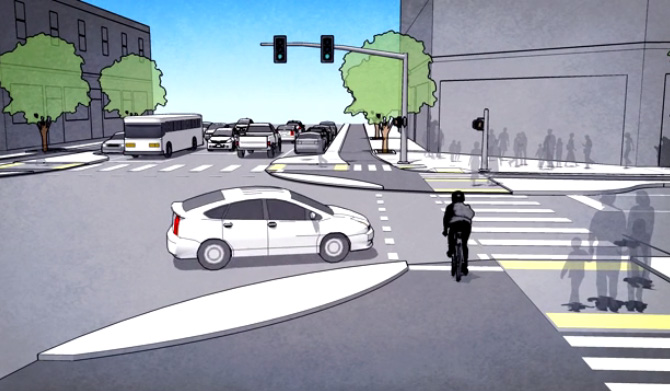
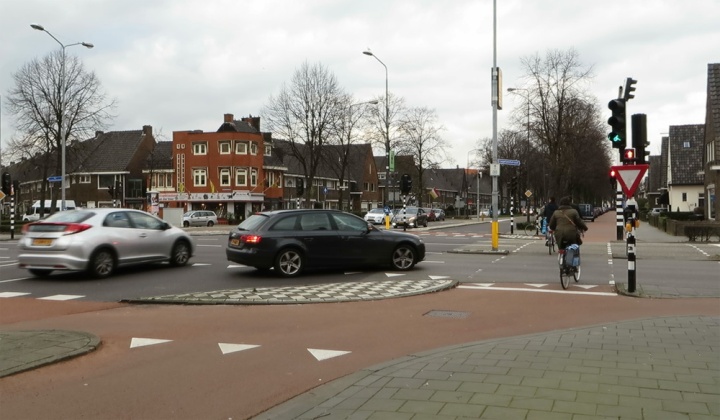
Some people misinterpreted the focus on the protective traffic island in the corners. I started with those in the animation because that was an easy way to explain the design. In reality that island is the last thing on a Dutch designer’s mind.
“These traffic islands are not always the same and not even symmetric, they are the result of the tight radius for right turning cars to decrease their speeds on the intersection and the decision to design the cycle track slightly bent away from the intersection”, explains Dick van Veen. “This not only creates a safe waiting place for people cycling, but also a waiting place for exactly one car in that turn. It is right before the crossing place for people walking and cycling, but it is at the same time out-of-the-way from straight going motor traffic. This is a most important fact that is easily overlooked: the location of the stop line for cyclists. Another reason for the bent out cycle path is to make the distance between the carriage way and the cycle path large enough for a wheel chair or a mother with a baby carriage to stand there and wait for a safe crossing moment.” The advantage of this design is threefold: you create a safe place for motor traffic, for people cycling and for people walking.
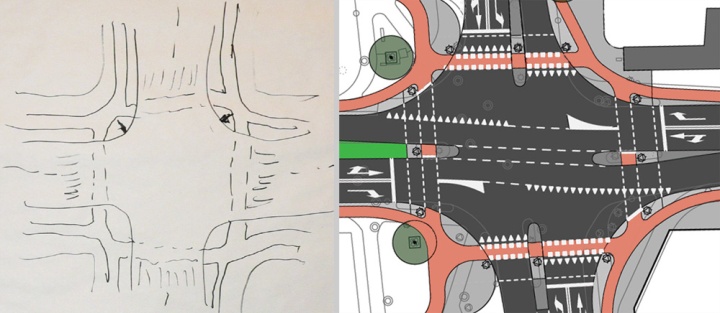

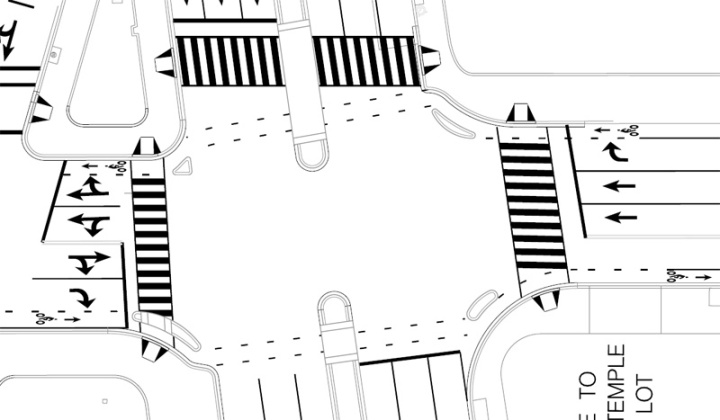
The one car length long waiting area in the turn makes that traffic lights can be arranged in a flexible way. In the Dutch situation a straight going cyclist as well as someone crossing the street on foot always have priority over the turning car. So even when the traffic signals are not working the car must wait and has a place to safely do so. When there are traffic signals the best solution is a separate green phase for straight going cyclists and turning cars. “But,” adds Dick van Veen, “no extra phase for cycling is needed. Dutch traffic signals work in a more sophisticated way and an intelligent and complex way of creating signal phases makes it possible that traffic in completely different directions, especially also people cycling, can have green at the same moment together with pedestrians, or cars turning in another direction. The total waiting times for any type of traffic are then almost always under one minute, which is to keep traffic flow high and to discourage red light jumping.”
Further developments
Dutch junction design has developed further and a more modern solution is the Dutch single lane roundabout. Dick van Veen says: “This has been proven to be much safer because first of all a roundabout reduces conflict between motor vehicles. The tight dimensions decrease the speeds and at 20km/h everything becomes much safer. These roundabouts eliminate high-speed right-angle collisions because only head-to-tail collisions at lower speeds can occur. And second, different types of traffic cross each other’s path exactly where the speeds are lowest instead of where they are highest, which is the case on a traditional crossroads. Space is not the issue. A roundabout does not need more space than a crossroads. A circle with a diameter of 15 or 16 metres is already within accepted standards.” That the Dutch roundabout, including the cycle tracks all around it, can be built in almost the same space of a traditional junction is the reason why so many are being converted.
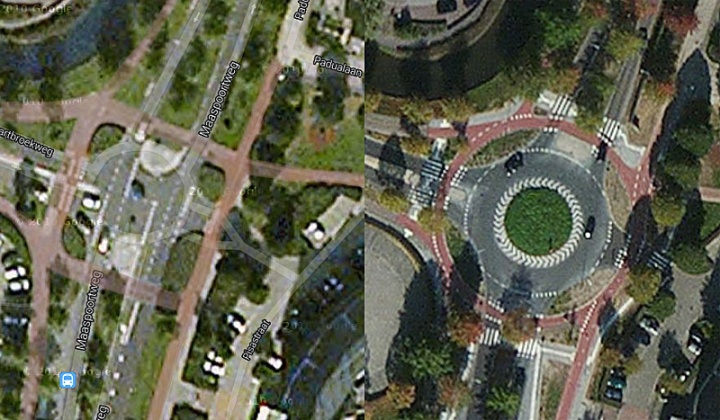
There are other developments too. In streets with a maximum speed of 30km/h separated cycling infrastructure is not necessary. Since the Netherlands now has about 35,000 kilometres of streets with such a speed limit we don’t see the design there. What we do see a lot is unbundling of different types of traffic at route level. What mostly happens is that through motor traffic gets a new detour around a certain area and the original direct routes with a substantially decreased volume of motor traffic can then be changed into a through route for cycling. Possibly as fietsstraat (a cycle street where motor traffic is not allowed to overtake people cycling). Such cycle routes then only cross main motor traffic routes at fewer places. This makes the construction of grade separated solutions feasible in terms of cost and space needed.
Good solution for (signalised) junctions
So there is an array of measures from which Dutch road designers can choose what is best for a particular situation. But in busy and older down town areas in larger cities there is often no space for the more elaborate measures with detours and tunnels or overpasses. And although even there we see an increasing number of roundabouts, this type of junction design – a crossroads with cycle paths around it, most often signalised – will remain the safest solution for a lot of places in the Netherlands.
Since many cities in the world have such signalised junctions, this solution to make cycling safer might work there too. So it is great to see a good interpretation like the one Nick Falbo has made.
A new video in which I try to explain Dutch junction design.


We designed and constructed an intersection like Falbo’s in Miami, Florida at SW 152nd Avenue and SW 152nd Street. SW 152nd Street received protected bicycle lanes indented from the roadway well spaced behind the curbs and adjacent to the sidewalks running for the one mile long project length. SW 152nd Avenue allows cycling on street with bicycle ramps approaching and departing the intersection. The project ran along SW 152nd Street from SW 147th Avenue to SW 157th Avenue, so the two signalized intersections at either end are hybrids. The bicycle facilities utilize the green color adopted by the US DOT.
Hello Mark, thanks for all this great info! I have a question – can this solution be adapted for junctions with free right turns for cars? I’m not talking about right turn on red but junctions where the right lane “breaks off” from the road and has a yield sign for right turns (basically like at time 0:12 in your video at the end of the post except that the light is replaced by a yield sign). Such a lane introduces another crossing for pedestrians and cyclists, so I’m guessing the answer is no but I’m still curious to hear. Thanks.
That’s not common here, but there are some examples of such an arrangement, like this one https://goo.gl/maps/nGuUwVZ8ffL2. It is on the list to be reconstructed very soon though.
There are a few more details that can round out this picture. Some of the City of Toronto staff go on about how a blind pedestrian can walk onto one of these fish shaped traffic islands and think they already crossed the road, disorienting them and making their crossing unsafe. I know this is false and that the videos show sensory tiles for the blind but a brief discussion would address this and relieve this concern.
Also, it would be helpful to share how these protective traffic islands fits in with other existing kinds of traffic islands, for other purposes. In Toronto’s St Clair Ave, the street is loaded with massive traffic islands to stop drivers from crashing into streetcars but there is nothing to accommodate bikes. Knowing the diverse array of traffic islands already in use shows that the one for separating cars and bikes is not so exceptional.
Keep up the great work! Let’s keep forging ahead for the sake of road safety. It makes no sense that people should get killed and so regularly just because they went for a walk, a bike ride or a drive or waited for a bus.
Hi, this is a really interesting post, thanks. Just a note about the Christchurch concept though – while I agree with some of the points you’ve made, note that in New Zealand we have far-side signals (as well as near-side ones) so a cyclist making a right turn will still be able to see the signals relevant to the second stage of that turn (they would still have a problem of the hold lines being in the wrong place though!)
I also remind people that this design, with the corner refuge islands and advance location of cyclists at setback crossing also can work with non roundabout, non signalized intersections but instead controlled with a stop sign, or more likely in the Netherlands, a yield sign. When sightlines are clear enough and the volume is not too high, it works well.
Hello,
Thank you for your work, it is great. Would you know of evaluations of this type of intersection design?
Kind regards,
François
I beg to differ in the case of roundbouts. Traffic safety is improved for all modal types except for cyclists. For cyclist there is an increase in accidents compared to standard four way junctions.
“To achieve uniformity in priority on roundabouts, CROW (1998) advises not to give priority to cyclists on separate bicycle tracks on rural roundabouts, but to indeed give them priority on urban roundabouts. Cyclist do now no longer have priority on nearly all rural roundabouts, in agreement with the CROW recommendation. They have right of way on 60% of the urban roundabouts. […] However, from a road safety perspective cyclists should have no priority on urban roundabouts either.” Source: https://www.swov.nl/rapport/Factsheets/UK/FS_Roundabouts.pdf
As you can read on my post about roundabouts that SWOV report was a minority view. If I remember correctly it was also critised because it made no destinction in accidents with cyclists and mopeds. If the mopeds were separated from the cyclists the findings would have been different. 1998 was also relatively shortly after implementation. Now, many years later all traffic users are used to this priority arrangement and roundabouts get high markings for subjective safety also from people cycling.
What do you think about rural roundabouts? Should on their own cycle path, bicycles get the right of way or should motor traffic?
Ah, yes, SWOV, the bicycle helmet people.
Living in Los Angeles and realizing many of the difficulties in creating intersections like this, my first thought is where are you going to get the space on a major street in a big auto oriented city like LA? Then, if you do obtain the space, how are you going to construct anything major like this for the 1% mode share bicycles when 38% of the roads are in D or F condition?
After looking at the pictures for a few minutes, It suddenly dawned on me that these intersection bulb-outs would make it safer for pedestrians also.
Then, I looked at Nick Falbo’s video. This is when I remembered Clarence Eckerson’s Streetsfilm’s that he made of how intersections looked after heavy snowstorms in New York City. The space required to implement designs for bikeway intersections is very similar to what Clarence shows is the result of the heavy snowfall.
http://www.streetfilms.org/the-complete-origin-of-the-sneckdown/#more-56726
So, instead of approaching it as a safety improvement for mainly bicycles to communities and politicians, it could be a all inclusive to reduce potential traffic conflicts for pedestrians and cyclists. The driving and parking space for vehicles is still there, but it now makes it easier and safer for bicycle/pedestrians to cross the intersection. If people want to know what the heck is the city doing with our money on these construction projects, it will be much easier and convincing that there is a need for a safety improvement for vulnerable users due to the injuries that have occurred at an intersection.
One of easiest places to implement this type of intersection design on a U.S. street would be were there has been a road diet. Which is where a motor vehicle lane has been removed to install bike lanes. Instead of the bike lane moving over to the left of the right-turn-only lane for motor vehicles at the intersection, it would have enough space reallocated to remain to the right with a barrier separating bicycles from motor vehicles.
It would be much more difficult do this where bicycle lanes are usually installed in the leftover space where parked car doors open. Typically, when the intersection is approached in this application the bike lane disappears and is replaced by the right-turn-only lane for motor vehicles.
This also makes it easier to narrow down the locations where it could be first applied. Otherwise, in a city the size of Los Angeles, looking at it from the standpoint of having 16,000 intersections along collector and arterial streets, it would seem an impossible task to even start on even when narrowing it down to where there are bike lanes already installed.
Hi Mark, your original work communicating this concept really has had its harvest day now, with Nick Falbo’s remake: http://vimeo.com/86721046 Just by embedding Nick’s clip in my own blog, then posting a link to facebook, I’m getting thousands of hits. God knows how many people are watching Nick’s clip from other sources! So why viral interest in the remake, and not your original? I thinks it’s because the remake has a (possibly) American setting. It’s like when Elvis introduced black music to white america. But historians will always go back and find the Chuck Berry figures. So, keep it up Mark!
I should clarify: the remake doesn’t tell Americans this is the Dutch solution, which I think would make lots of average Americans tune out, as though the concept is something from Mars. Australians are not better. Us bike advocates communicate with each other because we look outside our own little worlds. Average folk don’t.
It’ sad, that Nick placed traffic lights in the wrong place. If they are placed at the right of bicycle path, no right turn is possible with current traffic regulations. If lights are on the left – they don’t mean anything for right turning cyclists.
Nick should correct that error.
From Canada, many thanks Mark for your timely and enlightening overview.
To help spread the word I’ve shared the video (with three stills) via Twitter, here:
http://tinyurl.com/phclrjj
and I’ve added the video plus many of your own photos to the Streets for everyone Pinterest board, here:
There will inevitably be resistance to any implementation, but with luck we will soon see Dutch Junctions cropping up everywhere.
You wrote, “In the Dutch situation a straight going cyclist as well as someone crossing the street on foot always have priority over the turning car.”
There is no such law in most places in the US, so expecting right turning motorists to yield to through bicyclists on their right is unrealistic and dangerous.
Why do you think I expect that? I say no such thing. I do say that it is good to study Dutch designs. They would then have to be adapted to local laws. But with a separate green cycle (cleverly combined, so it is not prolonging the total cycle) that problem, that is not unique to the US, can be fixed.
Laws of a country are just social constructions, not like the laws of physics that can never be changed. Indeed the law should be updated and move forward as we learn more about the most safe and optimum ways of doing things.
Building codes, to pick one example, are not the same as they were 100 years ago, or even 5 years ago as we’ve learnt more about engineering, and that’s very important because they keep you from being killed or injured when your house falls down on your head. Why not when we learn more, keep the traffic laws up to date too?
It does look scary at first, doesn’t it? But ride a couple of those a few times in NL and you’re hooked. Just watch Mark’s other video from a rider’s perspective: http://www.youtube.com/watch?v=EXUF97p8fXQ
Oops, sorry, meant as a reply to Tim
This is great stuff. But to follow up on Bob’s comment, as a UK cyclist I get scared just watching the bits around 3:38 – 4:00 in the video. Given my recent experience of cycling in the UK there is NO WAY I would trust drivers around here to give way to me whether I had priority or not. One of those lorries only needs to fail to brake for me once…
And there’s no sign of the national legislation changing to provide safer options for cycling any time soon, while the government continues to pretend to be pro-cycling, but leaves the responsibility for the details with the local authorities. And even if they do have the motivation and the knowledge, they don’t have the tools. 😦
I’ve now watched the older videos, and Nick Falbo’s. They are all great; so clear and that junction design makes so much sense – I’ve also previously watched the videos on Pedestrianise London which give some insight into phasing examples.
I would love to see this kind of junction happen over here, but my earlier misgivings persist and it strikes me that one of the things that lets it work well is a level of consistency between junctions. If you implemented a junction like this in one place in the UK but kept the rest of the road network the same then I can’t see people using it correctly.
Again, this needs national leadership. Of course that’s our problem rather than yours.
Tim, seeing is believing. I’m a professional driver and I don’t own a car, so when I’m off it’s the bike for me. Believe me, when on my bike many motorists give me the right of way, even when they’re not obliged to do so, and I don’t think it’s because of my looks, it’s a very common sight. When on the job, I’m never in such a rush that I can’t wait for my turn, it’s a game of give and take and your reward is a smile, a nod or a wave. Even lorry-drivers can be patient here.
Don’t take my word for it, just book a holiday, bring your bike or rent an OV-fiets at almost any railway-station and try it out for yourself. No guarantee you won’t run into the occasional ass-hole, of course.
However, Tim’s point is that it works in the Netherlands, but may not work as designed (at least the parts about cyclists having priority, and motorists stopping for them in cases where a light isn’t telling them to) in countries where cyclists are commonly treated as second-class citizens by motorists.
Or, in other words, the “occasional asshole” you reference is far, far more common where he is.
I hope we don’t have so many more assholes…
But I think the problem is that the legislation (and therefore the infrastructure) here promotes the idea that driving is a god-given right, and all other modes of transport come second. Like many countries the UK has been trying to save money recently, and yet many times previously budgeted fuel tax rises have been cancelled – everyone has had to pay extra to save the drivers from more expensive petrol. Just one example of how drivers get prioritised.
So in this instance I would imagine this works in the Netherlands – and of course I believe it does – because these roundabouts are relatively common, the design is consistent across most of the Netherlands? And the design exists in a context where it is understood that cycling is prioritised.
In the UK, the road markings do not yet exist for this type of roundabout (although these ideas are being tested), and I worry that even if they were introduced and used by one local authority in one location, drivers would never imagine that they might have to give way to cyclists, and I don’t want to be the one in the way.
This kind of infrastructure needs to be introduced and rolled out nationally as part of a clearly stated policy to prioritise a mode of transport which makes us healthier and happier, and which pollutes and kills less often.
Laws can be changed to match reality. As it is, motorists must currently yield to pedestrians in or about to enter the crosswalk. All that is required is to extend that to bikes in or about to enter a bikeway crossing of an intersection and the legal problem is solved. The current weaving paradigm isn’t particularly pleasant or predictable.
It should also be noted that the Falbo video gathers the major idea, but misses out on small nuances. These can be seen in the two pictures Mark posted above. In the first one, the cycletrack has priority over the road, as denoted by the ‘shark teeth’ facing the road and the ‘elephant feet’ markings on the crossing. In the second, the situation is reversed and the cycletrack gives way to the street, as denoted by the ‘shark teeth’ being on it instead of in the road. Also, it just has regular dashed lines on its edges. Undoubtedly, purists will howl that that means bikes are being “marginalized”. But if signalized intersection stats are similar to roundabouts, that situation is likely safer than the first.
The reason why there are sometimes sharkteeth facing the cyclist is that there is always one road with priority over the other. The priority on the cycle track matches the priority on the carriageway. That has nothing to do with one being safer than the other, nor with one being better than the other. It’s just that one time the picture shows the road with priority and the other time the one without.
Regarding your last sentence: the safety stats on signalised intersections are completely different from roundabouts. The latter being much safer. Furthermore: in The Netherlands it is widely recognised by most experts and advisory bodies that giving cycling priority on roundabouts in the built-up area on cycleways which form a perfect circle is the best solution. Only one advisory body is against that and other bodies successfully challenged their findings. You give a link to the only other person in The Netherlands who thinks that way. But I need to point out that that is his view and I have different opinion.
Reality in the US is that motorists making right turns don’t check for bicyclists passing on their right. So passing a law without educating drivers to check their right mirror before turning right like you do in your country would be a disaster.
Also, apparently in your country motorists are required to yield to pedestrians “about to enter a crosswalk.” Not in the US. Here, motorists are only required to yield to pedestrians IN the crosswalk (meaning at least one foot in the traffic lane). Even then, yielding by motorists to pedestrians in crosswalks decreases as speed increases.
In the US, each state has its own traffic laws. I don’t know of any state that regulates operation of bicycles on a cycle track, or that says that turning motorists are required to yield to a bicycle on a cycle track. In California in the mid 1970’s, we decided to leave regulation of bicycle operation on sidewalks and paths up to local agencies (cities and counties), and I know of no local agency that requires motorists as a general rule to yield to bicyclists on a cycle track.
Also in the US, sharks teeth by themselves have no meaning – they must be accompanied by a YIELD sign. But our traffic control device standards do not allow the use of YIELD signs within an intersection controlled by a traffic signal.
All this means that you cannot simply import Dutch designs to the US without the laws, behaviors, education and enforcement that go along with them.
With reference to your comments that shark teeth must be accompanied by a YIELD sign and : …”our traffic control device standards do not allow the use of YIELD signs within an intersection controlled by a traffic signal,” that is not entirely accurate. Shark teeth can be accompanied by a YIELD HERE to Pedestrians sign (R1-5 or R1-5a) found on page 55 of the MUTCD (http://mutcd.fhwa.dot.gov/pdfs/2009r1r2/part2b.pdf) and the crossing is illustrated on page 383 in figure 3B-17 (http://mutcd.fhwa.dot.gov/pdfs/2009r1r2/part3.pdf). Also, whereas Section 4D.34 expressly prohibits STOP signs at signalized intersections with noted exceptions on pages 493-494 (http://mutcd.fhwa.dot.gov/pdfs/2009r1r2/part4.pdf), there is no corresponding prohibition of YIELD signs.
In most areas of the US there is a law that does say that turning traffic must yield to thru traffic, and even if there isn’t, the MUTCD has a sign that can create this right of way.
Reblogged this on Infrastructural and commented:
Junctions are where I’ve seen some of the worst examples of British cycle infrastructure, though to be fair to our traffic planners, they appear mostly to avoid the issue by stopping cycle lanes altogether at junctions.
I recommend watching the video at the end of this reblogged post. It shows clearly how several solutions work in practice (I’ve ridden through the Houten system, it was easy) . The final line in the film gets to the real point that road designers in UK miss altogether: it is designed so that a child can use it… So they do, along with everybody else!
Very nice, thank you! I like your approach here particulary. There is not the ONE solution, that every country must adapt to get happy and safe cyclists. There are a lot of different ways, and it can be even no cycling infastructure at all, by reducing car speed and car traffic in whole streets and areas.
It’s all about good planing, spending money for bike traffic and restrictments for car traffic if necessary.
In Munich, we got a lot of crappy and proven dangerous cycle paths along the Co-drivers-door zone of parked cars, with unclear, narrow and often chaotic design at junctions. Visitors from other countrys (which have not been in the Netherlands apparently) are often enthusiastic about these infrastructure, but many Germans are not.
The “state-of-the-art”-infrastructure are now wide cycle-lanes on the street. They may not be the best compared to dutch infrastructure, but there are a intelligent solution and an big improvement to the current situation. It’s all about intelligent change step by step, instead of declaring to have found the Holy Grail of cycling-infrastructure.
Please put a big red cross over wrong designs, and maybe they won’t be copied.